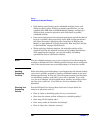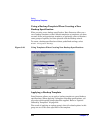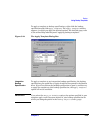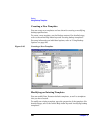
Backup
Selecting a Backup Type: Full or Incremental
Chapter 5 215
How to Read Table
5-1
• The rows in Table 5-1 are independent of each other and show
different situations.
• The age of the backups increases from right to left, so that the far left
is the oldest and the far right is the most recent backup.
• The full and IncrX represent still-protected objects of the same owner.
Any existing IncrX that is not protected can be used for restore, but is
not considered for referencing on subsequent backup runs.
Examples: • In the second row, there is a full, still protected backup and an Incr2
is running. There is no Incr1, so the backup is executed as an Incr1.
• In the fifth row, there is a full backup, an Incr1 and another
incremental is running. Data Protector references the currently
running backup to the previous incremental, that is Incr1.
• In the eighth row, the Incr3 is executed as Incr2, and in the eleventh
row, the Incr3 is executed as Incr1.
How to Select the
Backup Type
If you perform an interactive backup, you are prompted to select the
backup type. When scheduling a backup, you specify the backup type in
the Schedule Backup dialog. You can, for example, create a schedule
that runs the same backup specification as full on Saturday and as Incr1
on all working days.
Backup Type and
the Restore
Process
Keep in mind that full backups enable a simple and efficient restore, but
require many media that can hold multiple versions of the entire backed
up data. The time required to complete a backup is rather long.
Incremental backups require fewer media resources, but have a more
complex restore algorithm. Compare the following two examples:
1. full ; Incr ; Incr ; Incr ; Incr (-> time)
This example requires a shorter backup time and the media space
required is lower. The restore process is more complex; many media
need to be accessed, and the required time is longer if you want to
restore to the state of the last Incr.
2. full ; Incr1 ; Incr1 ; Incr1 ; Incr1 (-> time)
This example requires more time for backup and the media space
consumption is a bit higher if compared to the first example. The
restore process is simple; few media are needed, and the time spent
on performing a restore is shorter than in the first example.


















